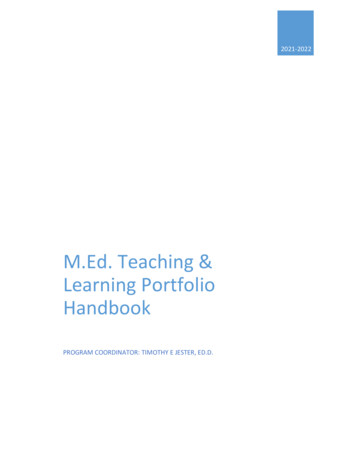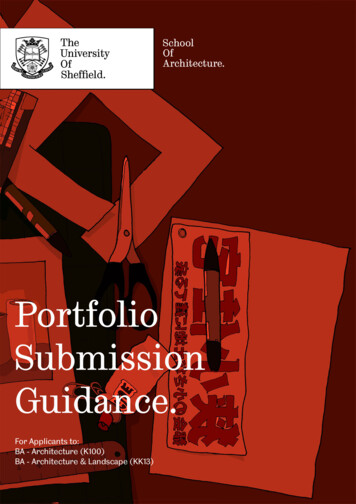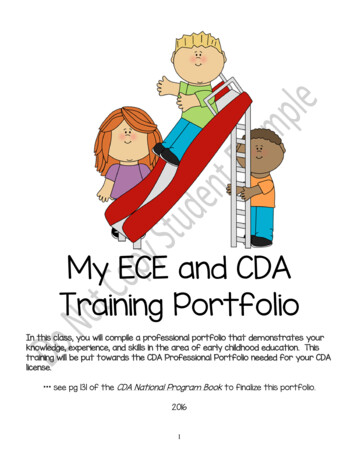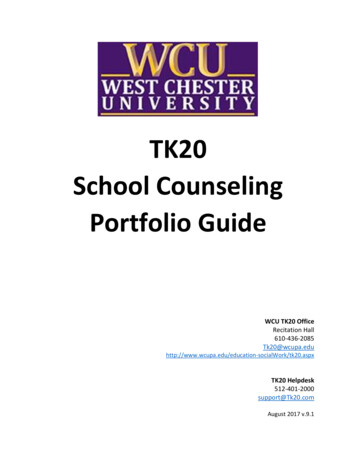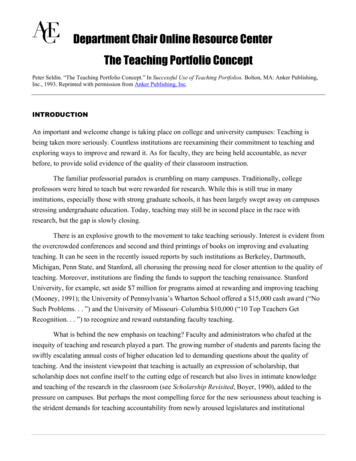
Transcription
Department Chair Online Resource CenterThe Teaching Portfolio ConceptPeter Seldin. “The Teaching Portfolio Concept.” In Successful Use of Teaching Portfolios. Bolton, MA: Anker Publishing,Inc., 1993. Reprinted with permission from Anker Publishing, Inc.INTRODUCTIONAn important and welcome change is taking place on college and university campuses: Teaching isbeing taken more seriously. Countless institutions are reexamining their commitment to teaching andexploring ways to improve and reward it. As for faculty, they are being held accountable, as neverbefore, to provide solid evidence of the quality of their classroom instruction.The familiar professorial paradox is crumbling on many campuses. Traditionally, collegeprofessors were hired to teach but were rewarded for research. While this is still true in manyinstitutions, especially those with strong graduate schools, it has been largely swept away on campusesstressing undergraduate education. Today, teaching may still be in second place in the race withresearch, but the gap is slowly closing.There is an explosive growth to the movement to take teaching seriously. Interest is evident fromthe overcrowded conferences and second and third printings of books on improving and evaluatingteaching. It can be seen in the recently issued reports by such institutions as Berkeley, Dartmouth,Michigan, Penn State, and Stanford, all chorusing the pressing need for closer attention to the quality ofteaching. Moreover, institutions are finding the funds to support the teaching renaissance. StanfordUniversity, for example, set aside 7 million for programs aimed at rewarding and improving teaching(Mooney, 1991); the University of Pennsylvania’s Wharton School offered a 15,000 cash award (“NoSuch Problems. . . ”) and the University of Missouri–Columbia 10,000 (“10 Top Teachers GetRecognition. . . ”) to recognize and reward outstanding faculty teaching.What is behind the new emphasis on teaching? Faculty and administrators who chafed at theinequity of teaching and research played a part. The growing number of students and parents facing theswiftly escalating annual costs of higher education led to demanding questions about the quality ofteaching. And the insistent viewpoint that teaching is actually an expression of scholarship, thatscholarship does not confine itself to the cutting edge of research but also lives in intimate knowledgeand teaching of the research in the classroom (see Scholarship Revisited, Boyer, 1990), added to thepressure on campuses. But perhaps the most compelling force for the new seriousness about teaching isthe strident demands for teaching accountability from newly aroused legislatures and institutional
Peter Seldin. “The Teaching Portfolio Concept.” In Successful Use of Teaching Portfolios. Bolton, MA: Anker Publishing,Inc., 1993. Reprinted with permission from Anker Publishing, Inc.governing boards. Facing an unrelenting budgetary squeeze, they are taking fresh, almost inquisitorialinterest, in knowing how faculty members spend their time and about their effectiveness as teachers.In short, the movement to improve and reward teaching and to take it seriously has become agroundswell across the nation. It has enlisted state legislatures, boards of trustees, financial donors,academic administrators, faculty members, parents, and students to press colleges and universities toscrutinize more carefully the classroom performance of each professor.Unfortunately, factual information on teaching performance is at best often skimpy. The typicalprofessor has little solid evidence about what they do in the classroom and how well they do it. True,they probably have student ratings but that’s about all, and student ratings alone fall far short of acomplete picture of one’s classroom performance. They may have a curriculum vitae, but typically thatlists publications, honors, research grants, and other scholarly accomplishments and says very littleabout teaching.Yet in the absence of factual information about teaching, how can it be evaluated? How can it berewarded? How can it be improved? And how can institutions give the teaching function its proper roleand value in the educational process? Is there a way for colleges and universities to respondsimultaneously to the movement to take teaching seriously and to the pressures to improve systems ofteaching accountability? The answer is yes. A solution can be found by turning to the teaching portfolio.It is an approach increasingly recognized and respected.WHAT IS A TEACHING PORTFOLIO?It is a factual description of a professor’s teaching strengths and accomplishments. It includesdocuments and materials that collectively suggest the scope and quality of a professor’s teachingperformance.The portfolio is to teaching what lists of publications, grants, and honors are to research andscholarship. As such, it allows faculty members to display their teaching accomplishments forexamination by others. And, in the process, it contributes both to sounder personnel decisions and to theprofessional development of individual faculty members (Seldin, 1991). As a result, it provides a strongsignal that teaching is an institutional priority.Department Leadership Projectace departmentchairs@ace.nche.eduPage 2American Council on Educationhttp://www.acenet.edu/resources/chairs/
Peter Seldin. “The Teaching Portfolio Concept.” In Successful Use of Teaching Portfolios. Bolton, MA: Anker Publishing,Inc., 1993. Reprinted with permission from Anker Publishing, Inc.Why would a faculty member want to prepare a teaching portfolio? They might do so in order tospell out for the record the hard evidence and specific data about their teaching effectiveness. That is aclear advantage when an evaluation committee examines academic credentials for tenure and promotiondecisions. Or they might do so in order to provide the needed structure for self-reflection about areas oftheir teaching needing improvement.An important point: The teaching portfolio is not an exhaustive compilation of all the documentsand materials that bear on teaching performance. Instead, it culls from the record selected informationon teaching activities and solid evidence of their effectiveness (Seldin, 1991). And, importantly, just asin a curriculum vitae, all claims in the portfolio should be supported by firm empirical evidence.To the skeptical professor who hesitates to spend valuable time preparing a teaching portfolio,Lemm (1992) offers this answer: As faculty, he says, we are trained to document our research andpublication activities. We update our curriculum vitae as we strive for tenure and promotion. But wedon’t document our teaching, nor are we expected to do so. Doesn’t it make sense to document teachingactivities with the same care and vigor we document research and scholarship? The portfolio enables aprofessor to present evidence of teaching achievements in an orderly, efficient, and persuasive way.The logic behind portfolios is straightforward. Earlier assessment methods, such as studentratings or peer observations, were like flashlights. That is, they illuminated only the teaching skills andabilities that fell within their beams. As such, they shed light on only a small part of a professor’sclassroom performance. But with portfolios, the flashlight is replaced by a searchlight. Its beamdiscloses the broad range of teaching skills, abilities, attitudes, and philosophies.Edgerton, Hutchings, and Quinlan (1991) make the case for teaching portfolios in this way:1.Portfolios provide documented evidence of teaching that is connected to the specifics andcontexts of what is being taught.2.They go beyond exclusive reliance on student ratings because they include a range ofevidence from a variety of sources such as syllabi, samples of student work, selfreflections, reports on classroom research, and faculty development programs.3.In the process of selecting and organizing their portfolio material, faculty think hardabout their teaching, a practice which is likely to lead to improvement in classroomperformance.Department Leadership Projectace departmentchairs@ace.nche.eduPage 3American Council on Educationhttp://www.acenet.edu/resources/chairs/
Peter Seldin. “The Teaching Portfolio Concept.” In Successful Use of Teaching Portfolios. Bolton, MA: Anker Publishing,Inc., 1993. Reprinted with permission from Anker Publishing, Inc.4.In deciding what should go into a portfolio and how it should be evaluated, institutionsnecessarily must address the question of what is effective teaching and what standardsshould drive campus teaching practice.5.Portfolios are a step toward a more public, professional view of teaching. They reflectteaching as a scholarly activity.The teaching portfolio is increasingly recognized and respected. Among the many presidents ofacademic institutions and associations supporting the portfolio approach are Derek Bok, former HarvardUniversity president; Donald Kennedy, president of Stanford University; Ernest Boyer, president of theCarnegie Foundation for the Advancement of Teaching (see Scholarship Revisited, 1990); and LynneCheney, chairman of the National Endowment for the Humanities (see Tyrannical Machines, 1990).The teaching portfolio concept has gone well beyond the point of theoretical possibility. It hasbeen used in Canada (where it is called a teaching dossier) for nearly 15 years. Today it is being adoptedor pilot-tested in various forms by an increasing number of American institutions.Although reliable numbers are hard to come by, it is estimated that as many as 400 colleges anduniversities in the United States are now using or experimenting with portfolios. That is a stunning jumpfrom the approximately 75 institutions thought to be using portfolios just two years ago. Among thecurrent users or experimenters with portfolios are: Texas A&M University, Columbia College (SouthCarolina), University of Maryland, Miami-Dade Community College (Florida), St. Norbert College(Wisconsin), New Community College of Baltimore (Maryland), the University of Nebraska, andMurray State University (Kentucky).THE IMPORTANCE OF COLLABORATIONShould portfolios be developed by the professor working alone, or should they becollaborative efforts? From mounting experience, we know now that they are best prepared inconsultation with others. The reason, says Seldin (1991) and Bird (1989) is because portfolios preparedby the professor working alone do not include the collegial or supervisory support needed in a programof teaching improvement. And, importantly, there is none of the control or corroboration of evidencethat is essential to sustain personnel decisions. That is why portfolio development should involveinteraction and mentoring in the same way that a doctoral dissertation reflects both the efforts of thecandidate and the advice of the mentor.Department Leadership Projectace departmentchairs@ace.nche.eduPage 4American Council on Educationhttp://www.acenet.edu/resources/chairs/
Peter Seldin. “The Teaching Portfolio Concept.” In Successful Use of Teaching Portfolios. Bolton, MA: Anker Publishing,Inc., 1993. Reprinted with permission from Anker Publishing, Inc.Who might serve as a mentor? A department chair, a colleague, or a faculty development specialistcould fill the role. They discuss with the professor such key questions as: Which areas of the teachinglearning process are to be examined? What kinds of information do they expect to collect? How is theinformation to be analyzed and presented? Why are they preparing the portfolio?One caution: Whoever serves as portfolio consultant/mentor must have wide knowledge ofprocedures and current instruments to document effective teaching. In this way, the consultant can assistthe faculty member by providing suggestions and resources, and maintaining support during thepreparation of the portfolio (Seldin, 1991). This point is discussed in detail, this volume, in the chapterby Annis.A second caution: Because faculty members and institutional contexts differ widely, there isno one “best” way to structure the collaboration. Edgerton, Hutchings, and Quinlan (1991) offer theseapproaches:1.A buddy system in which two faculty pair up for a semester to visit each other’s classes,talk to their students, confer on syllabi, exercises, and exams, and then assist each otherin documenting their teaching in their respective portfolios.2.A mentoring system where the older, more experienced professor works directly with ayounger colleague in assisting them as they develop their portfolio.3.A department-based portfolio project in which discussions about teaching can be moresharply focused and richer because they are focused on the discipline.Since “teaching tends to be a private, solitary activity,” Edgerton, Hutchings, and Quinlan (1991,p. 51) conclude that “collaboratively designed portfolios are an antidote to this isolation and a way topromote collegial exchange focused on the substance—the scholarship—of teaching.”Although some professors will prepare their portfolios in collaboration with their departmentchair, experience tells us that most will end up working with someone else. Therefore it is of specialimportance that a periodic, written exchange of views between the chair and the professor take placeabout: (1) teaching responsibilities; (2) other duties related to teaching; (3) the general content andstructure of the portfolio; and (4) how teaching performance is to be reported. “Otherwise,” cautionsDepartment Leadership Projectace departmentchairs@ace.nche.eduPage 5American Council on Educationhttp://www.acenet.edu/resources/chairs/
Peter Seldin. “The Teaching Portfolio Concept.” In Successful Use of Teaching Portfolios. Bolton, MA: Anker Publishing,Inc., 1993. Reprinted with permission from Anker Publishing, Inc.Seldin (1991, p. 6) “there is a danger that the department chair may erroneously conclude that the datasubmitted overlook areas of prime concern and may even cover up areas of suspected weaknesses.”SIX STEPS TO CREATE A TEACHING PORTFOLIOExperience suggests that most faculty members rely on the following step-by-step approach in creatingtheir portfolios. It is based on the work of Shore and others (1986), Seldin (1991), and O’Neil andWright (1992).Step 1. Clarify Teaching Responsibilities. Typically, this covers such topics as courses currentlytaught and those taught in the recent past, teaching-related activities such as serving as faculty advisor tostudent organizations, or advising individual graduate or undergraduate students. It is based on theexchange of memos between the department chair and the faculty member.Step 2. Select Items for the Portfolio. Based on the teaching responsibilities described in Step 1,the professor selects items for inclusion in the portfolio which are directly applicable to their teachingresponsibilities.Step 3. Prepare Statements on Each Item. Statements are prepared by the professor on activities,initiatives, and accomplishments on each item. Backup documentation and appendices are referenced, asappropriate.Step 4. Arrange the Items in Order. The sequence of the statements about accomplishments ineach area is determined by their intended use. For example, if the professor intends to demonstrateteaching improvement, such activities as attending faculty development workshops and seminars shouldbe stressed.Step 5. Compile the Support Data. Evidence supporting all items mentioned in the portfolioshould be retained by the professor and made available for review upon request. These would include,for example, letters from colleagues and students, original student evaluations of teaching, samples ofstudent work, and invitations to contribute articles on teaching in one’s discipline. Such evidence is notpart of the portfolio but is backup material placed in the appendix or made available upon request.Department Leadership Projectace departmentchairs@ace.nche.eduPage 6American Council on Educationhttp://www.acenet.edu/resources/chairs/
Peter Seldin. “The Teaching Portfolio Concept.” In Successful Use of Teaching Portfolios. Bolton, MA: Anker Publishing,Inc., 1993. Reprinted with permission from Anker Publishing, Inc.Step 6. Incorporate the Portfolio into the Curriculum Vitae. Lastly, the portfolio is theninserted into the professor’s curriculum vitae under the heading of “Teaching” or “Instruction.”Departmental guidelines will determine its precise location in the c.v. in relation to the sections on“Research” and “Service.”CHOOSING ITEMS FOR THE PORTFOLIOThere are many possibilities from which items can be selected that are especially relevant to theprofessor’s particular teaching situation. The items chosen also depend, to some degree, on whether theportfolio is prepared for purposes of improvement or personnel decision, and on any format or contentrequirements of a professor’s department or institution.Based on empirical evidence, it is clear that certain items turn up in portfolios with much morefrequency than others. From a personal review of more than 400 portfolios prepared by professors inboth public and private institutions, the writer can assert that certain items appear again and again.Material from Oneself Statement of teaching responsibilities, including course titles, numbers, enrollments, and a briefdescription of the way each course was taught. Representative course syllabi detailing course content and objectives, teaching methods,readings, and homework assignments. Description of steps taken to improve teaching, including changes resulting from self-evaluation,reading journals on teaching improvement, and participation in programs on sharpeninginstructional skill. Instructional innovations and evaluation of their effectiveness. A personal statement by the professor describing teaching goals for the next five years.Department Leadership Projectace departmentchairs@ace.nche.eduPage 7American Council on Educationhttp://www.acenet.edu/resources/chairs/
Peter Seldin. “The Teaching Portfolio Concept.” In Successful Use of Teaching Portfolios. Bolton, MA: Anker Publishing,Inc., 1993. Reprinted with permission from Anker Publishing, Inc.Material from Others Student course or teaching evaluation data which produce an overall rating of effectiveness orsuggest improvements. Statements from colleagues who have observed the professor in the classroom. Documentation of teaching development activity through the campus center for teaching andlearning. Statements from colleagues who have reviewed the professor’s teaching materials, such ascourse syllabi, assignments, testing and grading practices. Honors or other recognition, such as a distinguished teaching award.The Products of Good Teaching A record of students who succeed in advanced study in the field. Student publications or conference presentations on course-related work. Testimonials from employers or students about the professor’s influence on career choice. Student scores on pre- and post-course examinations.These are the most commonly selected items, but by no means are they the only ones to appear inportfolios. Some professors, for reasons of discipline or institution or personal predilection, choose adifferent content mix.Some Items that Sometimes Appear in Portfolios Description of curricular revisions, including new course projects, materials, and classassignments. Self-evaluation of teaching-related activities. Contributing to, or editing, a professional journal on teaching the professor’s discipline.Department Leadership Projectace departmentchairs@ace.nche.eduPage 8American Council on Educationhttp://www.acenet.edu/resources/chairs/
Peter Seldin. “The Teaching Portfolio Concept.” In Successful Use of Teaching Portfolios. Bolton, MA: Anker Publishing,Inc., 1993. Reprinted with permission from Anker Publishing, Inc. A statement by the department chair assessing the professor’s teaching contribution to thedepartment. Invitations to present a paper on teaching one’s discipline. A videotape of the professor teaching a typical class. Participation in off-campus activities related to teaching in the professor’s discipline. Evidence of help given to colleagues leading to improvement of their teaching. Description of how computers, films, and other nonprint materials are used in teaching. Statements by alumni on the quality of instruction. Examples of graded student essays, along with the professor’s comments on why they were sograded.How much information and evidence is needed to fairly represent a professor’s teachingperformance? There is no simple answer. Each professor must set the balance scale between “too much”and “not enough” information. However, for most professors, six to eight pages plus supportingappendix material is sufficient.The appendix material needs careful attention to be sure all the statements on teachingaccomplishments are adequately supported. In deciding what to include, it is best not to engage inoverkill. O’Neil and Wright (1992) suggest that the professor maintain a file of all relevant records onteaching. The best examples should be chosen for the portfolio and evaluators informed that additionalevidence is available upon request.Keep in mind that the portfolio is a living document that changes over time. New items are added.Others are removed. Updating a portfolio becomes a simple matter of dropping items pertaining toteaching into a file drawer just as is now done for research and service. Little time or effort is involved.When the research and service sections of the curriculum vitae are being updated, simply do the samefor the teaching section.Department Leadership Projectace departmentchairs@ace.nche.eduPage 9American Council on Educationhttp://www.acenet.edu/resources/chairs/
Peter Seldin. “The Teaching Portfolio Concept.” In Successful Use of Teaching Portfolios. Bolton, MA: Anker Publishing,Inc., 1993. Reprinted with permission from Anker Publishing, Inc.USING THE PORTFOLIO FOR PERSONNEL DECISIONSBecause each portfolio is unique, like a fingerprint, no two are exactly alike. The content andorganization differ from one professor to another. This approach works well if the portfolio is used forimprovement purposes. But it works less well if the portfolio is used for personnel decisions.One way, says Seldin (1989), to lay the problem to rest is to require those portfolios used fortenure and promotion decisions, or for teaching excellence awards, to include certain mandated itemsalong with the elective ones. Among the institutions adopting this approach are Murray State University(Kentucky), Pace University Business School (New York), Marquette University (Wisconsin), and theUniversity of Colorado at Boulder. At Murray State University, for example, all faculty are expected toinclude in their portfolios: (1) a reflective statement; (2) course syllabi; (3) examinations; (4) gradedassignments; and (5) student rating reports.At the Pace University Business School, faculty are urged to include: (1) a statement of teachingphilosophy, (2) student evaluations and comments, (3) teaching awards, (4) innovative course materialsand technologies, (5) course syllabi and exams, and (6) evidence of the integration of contemporarybusiness theory and practice into classroom instruction.Since teaching is now being taken more seriously, professors looking for recognition as superiorteachers stand to benefit by providing tenure and promotion committees with their teaching portfolios. Itprovides evaluators with hard-to-ignore information on what they do in the classroom and why they doit. And by so doing, it avoids looking at teaching performance as a derivative of student ratings.Does the teaching portfolio approach really make any difference? See the chapter byShackelford in this volume and consider the typical comments from professors whose portfolios wereused for purposes of personnel decisions:A history professor in New Jersey: “Teaching is more important here now. My promotion to fullprofessor was largely due to my portfolio. It gave the P&T committee an analysis, prioritizing,and valuing of what I do in the classroom.”A sociology professor in California: “I knew I was a good teacher, but no one else did until theyread my portfolio. I got tenure!”Department Leadership Projectace departmentchairs@ace.nche.eduPage 10American Council on Educationhttp://www.acenet.edu/resources/chairs/
Peter Seldin. “The Teaching Portfolio Concept.” In Successful Use of Teaching Portfolios. Bolton, MA: Anker Publishing,Inc., 1993. Reprinted with permission from Anker Publishing, Inc.A foreign language professor in Nebraska: “In the last two years I’ve won three teaching awardsat the state and international level. Without the portfolio, none of this would have happened.”How do members of promotion and tenure committees feel about teaching portfolios? Considerthe following comments from members of committees:A committee member in Georgia: “It took time to learn how to evaluate portfolios. But once wedid, the richness of the data on teaching made our job a hell of a lot easier.”A committee member in Texas: “No doubt about it, we just make better tenure and promotiondecisions with portfolios.”It is important to keep in mind that use of the portfolio for personnel decisions is onlyoccasional. Its primary purpose is to improve teaching performance.USING THE PORTFOLIO TO IMPROVE TEACHINGIt is in the very process of creating the collection of documents and materials that comprise the portfoliothat the professor is stimulated to: (1) reconsider personal teaching activities; (2) rethink teachingstrategies; (3) rearrange priorities; and (4) plan for the future (Seldin and Annis, 1990). Agreementcomes from Edgerton, Hutchings, and Quinlan (1991), who say that portfolios possess a special powerto involve faculty in reflecting on their own classroom practices and how to improve it.There are three important reasons why the portfolio is such a valuable aid in professionaldevelopment: (1) It is grounded in discipline-based pedagogy, that is, the focus is on teaching aparticular subject to a particular group of students at a particular time; (2) the level of personalinvestment in time, energy, and commitment is high (since faculty develop their own portfolios), andthat is a necessary condition for change; and (3) it stirs many professors to reflect on their teaching in aninsightful, refocused way. (See the section on Gordon College by Raymond, this volume, for furtherdiscussion on portfolios as an aid in faculty development.)When used for improvement purposes, the portfolio contains no mandated items. Instead, itcontains only items chosen by the professor working in collaboration with a consultant/mentor. TheDepartment Leadership Projectace departmentchairs@ace.nche.eduPage 11American Council on Educationhttp://www.acenet.edu/resources/chairs/
Peter Seldin. “The Teaching Portfolio Concept.” In Successful Use of Teaching Portfolios. Bolton, MA: Anker Publishing,Inc., 1993. Reprinted with permission from Anker Publishing, Inc.professor may decide, for example, to improve one particular course and include such items as: (1) asummary of instructional methods used; (2) specific course objectives and the degree of studentachievement of those objectives; (3) a full-period videotape of a typical class; and (4) student ratingscontaining both diagnostic and summative questions. (See the Barber and Perry portfolios, this volume,for examples of portfolios prepared for teaching improvement.)The bottom-line question, of course, remains. Do portfolios actually improve teaching? Themost candid answer is frequently yes but not always. Experience on campus after campus suggests thatif the professor is motivated to improve, knows how to improve, or where to go for help, improvementis quite likely. Consider these comments:A marketing professor in Oregon: “I hadn’t really thought about my teaching before. Butpreparing a portfolio made me think about why I do what I do in the classroom. Now I’mbreaking out of the old, tired examples and cases. I’m trying new things.”A biology professor in South Carolina: “I confess I was very skeptical at first. But the portfolioled me to rethink my entire approach to teaching. For the better, I must add.”A mathematics professor in Illinois: “I only wish I had learned about the portfolio concept 20years ago. It sure would have improved my teaching.”An educational psychology professor in Florida: “I believe that every new and experiencedfaculty member can improve their teaching by preparing a portfolio. It’s not a quick-fixapproach. But it sure is helpful.”USING PORTFOLIOS FOR OTHER PURPOSESSome professors prepare portfolios in order to take them on the road as they seek a different teachingposition. Generally, the portfolio is submitted in advance of an interview as an aid to presenting a morecomplete teacher to the institution. And some institutions are now requiring portfolios from professorsapplying for teaching positions.Department Leadership Projectace departmentchairs@ace.nche.eduPage 12American Council on Educationhttp://www.acenet.edu/resources/chairs/
Peter Seldin. “The Teaching Portfolio Concept.” In Successful Use of Teaching Portfolios. Bolton, MA: Anker Publishing,Inc., 1993. Reprinted with permission from Anker Publishing, Inc.Portfolios are now widely used to help determine winners of awards for outstanding teaching orfor merit pay consideration. And excerpts from portfolios are increasingly used in successful facultygrant applications.GAINING ACCEPTANCE OF THE PORTFOLIO APPROACHTo say that the teaching portfolio approach is useful is one thing, but to get the approach off the groundis quite another. To begin with, there are social and attitudinal problems. Some professors automaticallyresist by evoking various academic traditions. They say that faculty members are not comfortable asself-promoters, don
The Teaching Portfolio Concept Peter Seldin. "The Teaching Portfolio Concept." In Successful Use of Teaching Portfolios. Bolton, MA: Anker Publishing, Inc., 1993. Reprinted with permission from Anker Publishing, Inc. INTRODUCTION An important and welcome change is taking place on college and university campuses: Teaching is



